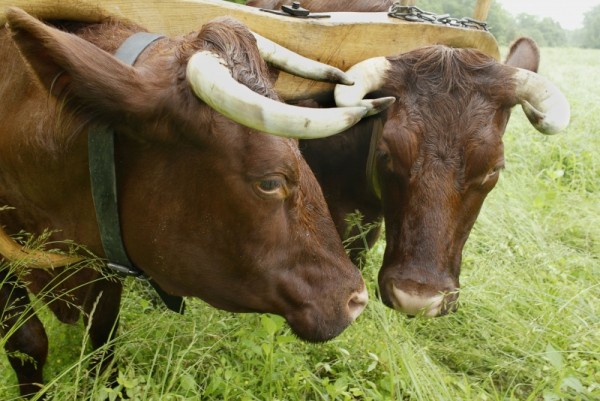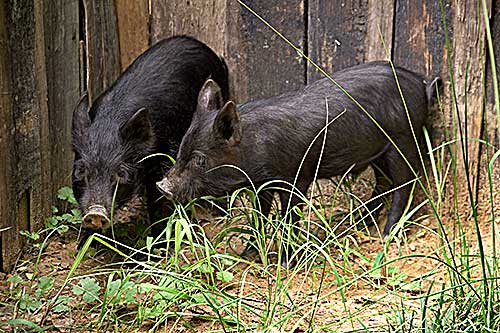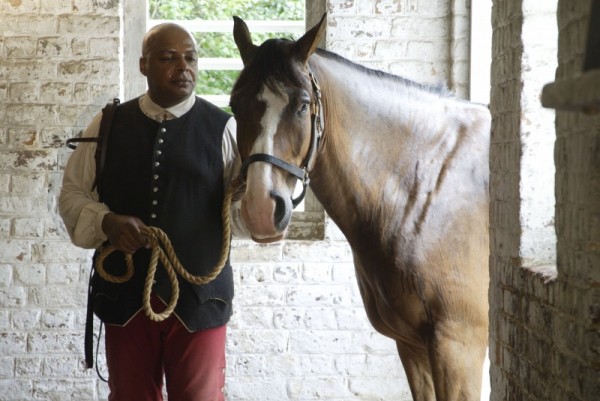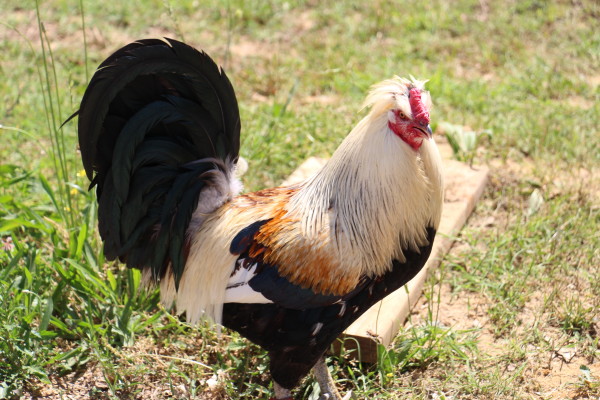 By Toni Guagenti
By Toni Guagenti
It isn’t only people that populate the Revolutionary City. Visitors could also find themselves eye-to-eye with oxen, pigs, sheep, horses and chickens.
Both bird and beast played a vital role in the lives of colonists during the 18th century — for money, for work and for food.
Many are represented in the Colonial Williamsburg’s Rare Breeds program, started nearly 30 years ago to preserve the genetic diversity in livestock.
Research indicates that animals like the ones in the program represent what could have been present in Williamsburg during the 18th-century.
Today, these animals might not serve in the exact same capacity they did for our forefathers and foremothers, but visitors will get a chance to learn how they did their part on the road to America’s independence.
Oxen
“Haw,” says Ed Schultz, the Colonial Williamsburg Foundation’s historic farming supervisor and historic farmer. Duke and Dan, Colonial Williamsburg’s oxen farm team — part Devon, part Lineback — methodically start turning to the left. The pair moves easily for their size. Dan is roughly 2,500 pounds, while Duke is about 200 pounds lighter.
They obey Schultz’s every command.
They have the pick of pastures at Great Hopes Plantation, Williamsburg’s re-creation of an 18th-century family farm.
“If you come here, you’re likely to see the oxen,” says Schultz, who considers his four-legged partners part of the historic farming team.
But will they be working?
“If I need them, I use them and only then,” says Schultz, one of Williamsburg’s two historic farmers. Their work isn’t part of a demonstration – it’s real and depends on the needs of the crops.
“My trade helps connect people” to America’s farming past, he says.
Visitors can learn about how the oxen plow and harrow the land in preparation for cotton, tobacco, wheat and corn grown during the pre-Revolutionary days. Today, they work in pairs, yoked together.
Schultz says the pair – trained to do draft work — came to Colonial Williamsburg when they were 2 years old. They’re now almost 9.
“I make sure I treat them with the dignity of an ox,” he said. “They’re here to work.”
Two other oxen, Dan (there are two Dans) and Dick, work in the Historic Area, and do a lot of hauling for the tradesmen and tradeswomen. They are Milking Shorthorns, a breed of British cattle popular during the 19th century.
Want to know more?
Ossabaw pigs
Not far from the dark-cherry-colored oxen, three black, mud-covered pigs roam an enclosed pen. They look nothing like the cuddly pink “Babe,” from the 1995 movie about a pig raised by sheepdogs.

These pigs sport sparse hair and they keep largely to themselves.
They are descendants of the Ossabaw Island pigs, which lived off the coast of Georgia, and were once allowed to roam free and fend for themselves.
“This is the closest you can come to an 18th century pig,” Schultz says.
They were a big part of the settlers’ diets, from livers to bacon. Most of the meat was cured, which led to one of Virginia’s most famous delicacy — The Virginia ham.
Ossabaw Island pigs came to the Revolutionary City in 2005. The pigs come from Mount Vernon, where each summer, the herd is culled to control its size. About seven of the animals are sent to Williamsburg.
They are fattened at their new home at Great Hopes Plantation and then used in the kitchen program. The Historic Trades Foodway staff at Great Hopes and the Randolph Kitchen interpreters use the animal meat. They prepare fresh dishes and preserve hams by salting them.
Want to know more?
Leicester Sheep
 Now that the lambing season is over, the last one was born in May, the Leicester Longwool Sheep that call the Revolutionary City home can be found out and about in various pastures in the Historic Area. The ewes can be found in one group; the males in another.
Now that the lambing season is over, the last one was born in May, the Leicester Longwool Sheep that call the Revolutionary City home can be found out and about in various pastures in the Historic Area. The ewes can be found in one group; the males in another.
Ewes birthed 18 lambs this season, according to Elaine Shirley, manager of the Colonial Williamsburg Foundation’s Rare Breeds Program. A lot of times, you can find them curled up in the historic area, staying out of the heat, she said.
You’ll know them when you see a healthy, lustrous coat which falls in ringlets. These sheep are known for their curly coat, ease of feeding, valuable meat supply and quick maturation.
Come fall, breeding will begin again to time births for the spring season, around Easter. Until then, the playful young ones will entertain Williamsburg visitors while also providing an education about the history of breeds like the Leicester during Colonial times.
Want to know more?
Horses
Whoa! Who’s that on horseback? Could it be George Washington?
How about a relaxing carriage ride through the Historic Area?
Visitors get a chance to experience colonial transportation by hopping aboard the ever-popular horse-drawn carriage, a mainstay in Historic Area for more than half a century.
Or they can stand by and watch the majestic animals trot along, sometimes with America’s first president at the reins.

Interpreter James Ingram portrays a groomsman in the stable.
Two rare breeds that are a part of the living-history experience including the American Cream Draft horse, the only draft-breed horse originating in the United States, and the Canadian horse, first developed from horses sent to Quebec from France in the 17th century.
Colonial Williamsburg’s more than two dozen horses are kept in the stables or in nearby pastures off Lafayette Street outside the Historic Area. But during the summer, they can be seen and enjoyed all day long.
Holders of annual passes at Colonial Williamsburg or those staying in hotels, can take advantage of a tour called “Bits and Bridles” to find out more about the animals and carriages.
The one-hour walking tour includes a tour of the stables, a look at the vehicles used, and a discussion of the treatment and training of the animals.
You may even get to try a sidesaddle, inspect a horse’s hoof or come nose-to-beak with one of Colonial Williamsburg’s rare chickens.
Want to know more?
Chickens
On a recent Wednesday, five cages sat under a shade tree near the stables.

Each contained a different chicken for “Bits and Bridle” visitors to see. They included the Nankin, Bantam, Silkie, an Old English Game hen and the rare Dominque.
One chicken, hidden from view, was sitting on about a dozen eggs, waiting for them to hatch. Nearby, hatchlings a month old and three months old respectively chirped in their pens.
The varieties include the Dominque, one of the first breeds of chickens developed in the United States, the Nankin Bantam, popular in the 19th and 20th centuries, and the English Game Fowl, originally bred for cockfighting. Then there’s the Red Dorking, which has five toes.
Visitors can see the chickens bopping around in pens at the Wythe House, the Benjamin Powell House, Wetherburn’s Tavern and at Great Hopes Plantation, Shirley said. At night, they retire to their coops.
Want to know more?
American Milking Devon Cattle
Just as you may see some lambs or young sheep running around the Historic Area, you might also see a calf or two (one heifer is about to give birth).
They are part of the historic city’s American Milking Devons population of cattle. They were the first acquisition for Colonial Williamsburg’s Rare Breeds program in 1986.
They are known for their high-butterfat milk, which was especially important in the 18th century for butter and cheese.
Visitors can have fun trying to find all of the historic city’s animals, “if you know where to look,” Shirley says.
Want to know more?
Animal things to do in Colonial Willliamsburg:
So if you want to know where to look, be sure to ask ticket-takers where the animals are for the day, Shirley says. They get updates every morning.
There are more ways to be around the animals.
Carriage Rides: Operate daily weather permitting. Carriage rides may be booked at onsite ticket offices.
Rare Breeds Program: Join us Monday and Thursday throughout the summer at 11 a.m. to discover more about the program.
Bits and Bridles: Available for annual pass members and hotel guests.
The Artful Animal: This guided expedition through our museum galleries go in search of animals – in art.
Historic Farming: See how farmers would have worked with livestock in the 18th century.
Leave a Reply